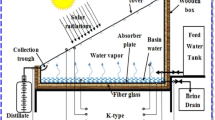Abstract—
The limited productivity of conventional solar still is considered as the main obstacle that restricts their implementation. Hence the objective of the current study is to enhance the productivity of conventional solar still (CSS) by increasing the evaporation area using a rotating hollow drum. Many factors have been considered in the investigation of the enhanced solar still (ESS) productivity; including environmental factors and operation factors such as drum rotational speed. Three rotational speeds have been used in the experimental tests (0.5, 1, and 3 rpm) during three typical days 12, 13, and 14 June 2019. All tests done for 12 h from 8:00 am to 20:00 pm. Study results showed that the productivity enhanced by about 161% with 0.5 rpm, 111% with 1 rpm, and 75% with 3 rpm rotational speed compared to conventional solar still. Accordingly, the productivity increased with decreasing rotational speed and the maximum value obtained at the lower speed (0.5 rpm).





Similar content being viewed by others
REFERENCES
Radjabian, M. and Abetz, V., Advanced porous polymer membranes from self-assembling block copolymers, Prog. Polymer Sci., 2020, vol. 102, id. 101219. https://doi.org/10.1016/j.progpolymsci.2020.101219
Liu, T.K., Weng, T.H., and Sheu, H.Y., Exploring the environmental impact assessment commissioners’ perspectives on the development of the seawater desalination project, Desalination, 2018, vol. 428, pp. 108–115. https://doi.org/10.1016/j.desal.2017.11.031
Pugsley, A., Zacharopoulos, A., Mondol, J.D., and Smyth, M., Global applicability of solar desalination, Renewable Energy, 2016, vol. 88, pp. 200–219. https://doi.org/10.1016/j.renene.2015.11.017
Akhatov, J.S., Desalination of saline water with the use of RES: Demand, current situation, development trends, forecasts for the future (review), Appl. Sol. Energy, 2019, vol. 55, no. 2, pp. 133–148. https://doi.org/10.3103/s0003701x19020026
Muthu Manokar, A., Kalidasa Murugavel, K., Esakkimuthu, G., et al., Different parameters affecting the rate of evaporation and condensation on passive solar still – A review, Renewable Sustainable Energy Rev., 2014, vol. 38, pp. 309–322. https://doi.org/10.1016/j.rser.2014.05.092
Saadi, Z., Rahmani, A., Lachtar, S., and Soualmi, H., Performance evaluation of a new stepped solar still under the desert climatic conditions, Energy Convers. Manage., 2018, vol. 171, pp. 1749–1760. https://doi.org/10.1016/j.enconman.2018.06.114
Prakash, P. and Velmurugan, V., Parameters influencing the productivity of solar stills – A review, Renewable Sustainable Energy Rev., 2015, vol. 49, pp. 585–609.https://doi.org/10.1016/j.rser.2015.04.136
Aybar, H.Ş., Akhatov, J.S., Avezova, N.R., and Halimov, A.S., Solar powered RO desalination: Investigations on pilot project of PV powered RO desalination system, Appl. Sol. Energy, 2010, vol. 46, pp. 275–284. https://doi.org/10.3103/S0003701X10040080
Mahmoud, A., Fath, H., Ookwara, S., and Ahmed, M., Influence of partial solar energy storage and solar concentration ratio on the productivity of integrated solar still/humidification-dehumidification desalination systems, Desalination, 2019, vol. 467, pp. 29–42. https://doi.org/10.1016/j.desal.2019.04.033
Sharshir, S.W., Yang, N., Peng, G., et al., Factors affecting basin type solar still productivity: A detailed review, Renewable Sustainable Energy Rev., vol. 38, pp. 430–447, 2014. https://doi.org/10.1016/j.rser.2014.05.092
Srithar, K., Rajaseenivasan, T., Karthik, N., et al., Stand alone triple basin solar desalination system with cover cooling and parabolic dish concentrator, Renewable Energy, 2016, vol. 90, pp. 157–165. https://doi.org/10.1016/j.renene.2015.12.063
Gorjian, S., Ghobadian, B., Tavakkoli Hashjin, T., and Banakar, A., Experimental performance evaluation of a stand-alone point-focus parabolic solar still, Desalination, 2014, vol. 352, pp. 1–17. https://doi.org/10.1016/j.desal.2014.08.005
Omara, Z.M., Kabeel, A.E., and Essa, F.A., Effect of using nanofluids and providing vacuum on the yield of corrugated wick solar still, Energy Convers. Manage., 2015, vol. 103, pp. 965–972. https://doi.org/10.1016/j.enconman.2015.07.035
Jani, H.K. and Modi, K.V., Experimental performance evaluation of single basin dual slope solar still with circular and square cross-sectional hollow fins, Sol. Energy, 2019, vol. 179, pp. 186–194. https://doi.org/10.1016/j.solener.2018.12.054
Anburaj, P., Samuel Hansen, R., and Kalidasa Murugavel, K., Performance of an inclined solar still with rectangular grooves and ridges, Appl. Sol. Energy, 2013, vol. 49, pp. 22–26. https://doi.org/10.3103/S0003701X13010027
El-Samadony, Y.A.F. and Kabeel, A.E., Theoretical estimation of the optimum glass cover water film cooling parameters combinations of a stepped solar still, Energy, 2014, vol. 68, pp. 744–750. https://doi.org/10.1016/j.energy.2014.01.080
Kabeel, A.E. and Abdelgaied, M., Improving the performance of solar still by using PCM as a thermal storage medium under Egyptian conditions, Desalination, 2016, vol. 383, pp. 22–28. https://doi.org/10.1016/j.desal.2016.01.006
Rajasekhar, G. and Eswaramoorthy, M., Performance evaluation on solar still integrated with nano-composite phase change materials, Appl. Sol. Energy, 2015, vol. 51, pp. 15–21. https://doi.org/10.3103/S0003701X15010119
Ben Halima, H., Frikha, N., and Ben Slama, R., Numerical investigation of a simple solar still coupled to a compression heat pump, Desalination, 2014, vol. 337, pp. 60–66. https://doi.org/10.1016/j.desal.2014.01.010
Nazari, S., Safarzadeh, H., and Bahiraei, M., Performance improvement of a single slope solar still by employing thermoelectric cooling channel and copper oxide nanofluid: An experimental study, J. Cleaner Prod., 2019, vol. 208, pp. 1041–1052. https://doi.org/10.1016/j.jclepro.2018.10.194
Malaeb, L., Aboughali, K., and Ayoub, G.M., ScienceDirect modeling of a modified solar still system with enhanced productivity, Sol. Energy, 2016, vol. 125, pp. 360–372. https://doi.org/10.1016/j.solener.2015.12.025
Ayoub, G.M., Malaeb, L., and Saikaly, P.E., Critical variables in the performance of a productivity-enhanced solar still, Sol. Energy, 2013, vol. 98, pp. 472–484. https://doi.org/10.1016/j.solener.2013.09.030
Mahdi, J.T., Smith, B.E., and Sharif, A.O., An experimental wick-type solar still system: Design and construction, Desalination, 2011, vol. 267, pp. 233–238. https://doi.org/10.1016/j.desal.2010.09.032
Ayoub, G.M. and Malaeb, L., Economic feasibility of a solar still desalination system with enhanced productivity, Desalination, 2014, vol. 335, pp. 27–32. https://doi.org/10.1016/j.desal.2013.12.010
Haddad, Z., Chaker, A., and Rahmani, A., Improving the basin type solar still performances using a vertical rotating wick, Desalination, 2017, vol. 418, pp. 71–78. https://doi.org/10.1016/j.desal.2017.05.030
Ahmed, S.T., Study of single-effect solar still with an internal condenser, Sol. Wind Technol., 1988, vol. 5, no. 6, pp. 637–643.
Kabeel, A.E., Performance of solar still with a concave wick evaporation surface, Energy, 2009, vol. 34, pp. 1504–1509. https://doi.org/10.1016/j.energy.2009.06.050
ACKNOWLEDGMENTS
Authors appreciate the support from Ural Federal University in Yekaterinburg, Russia for providing the required instruments to achieve this research and thanks to all technical staff.
Author information
Authors and Affiliations
Corresponding author
About this article
Cite this article
Naseer T. Alwan, Shcheklein, S.E. & Ali, O.M. Effect of Hollow Drum Rotational Speed Variation on the Productivity of Modified Solar Still According to Yekaterinburg City, Russia. Appl. Sol. Energy 56, 276–283 (2020). https://doi.org/10.3103/S0003701X20040040
Received:
Revised:
Accepted:
Published:
Issue Date:
DOI: https://doi.org/10.3103/S0003701X20040040




